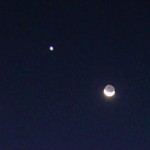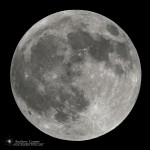Tonight the Moon will rendezvous with the bright star Spica in the constellation Virgo. The Moon is approaching full, just under 90% illuminated. Evening will see the two quite close, about 2° apart. As the night progresses this separation will diminish as the Moon slides just south of the star. For viewers in Hawai’i the minimum separation will be about 40′ around 2:00 in the morning with the star just 25′ from the Moon’s pole.
Tag: Moon
Mercury, Venus and Jupiter

On the evening of May 24th Venus and Mercury will be about 2° apart with Jupiter 4° above. Closest approach of the three will occur the evening of May 26th with the trio forming a neat triangle about 2° on a side. On the 28th Venus and Jupiter will be just over 1° apart. During the first few days of June, the planet Jupiter will bow out of the dance, exiting the stage into the Sun’s glare. Venus and Mercury will join up one more time for a few days after June 17th, with a close approach on the 19th and 20th with about 2° separation between the two. When Mercury also heads into the sunset this dance will end during the last days of June.
On the 9th and 10th of June the Moon will run across the stage, a very thin crescent around 2% illuminated and 6° south of the planets.
Much of the dance will take place about 15° above the sunset, high enough to be nicely visible, low enough that the glow of sunset will provide a colorful backdrop to light the stage.
The Moon, Venus and Jupiter
The sunset is getting crowded. This evening will see a trio of the sky’s brightest objects low in the shades of sunset. Venus is still quite low, ony 10.3° from the Sun, shining brightly at -4 magnitude and rising higher each day. Well above Venus can be seen Jupiter, somewhat dimmer at -2 magnitude and 23° from the Sun.
In between the two a pretty crescent Moon is positioned, 4.4% illuminated and about 5° below Jupiter. Tomorrow night will see the Moon above and south of Jupiter with about 7° separation.
This is just the start of a sunset dance that will play out over the coming month. Stay tuned for Mercury to join Venus and Jupiter.
Venus Appears in the Sunset
Venus is currently beginning an evening apparition. This evening the planet should be visible about 10° above the setting Sun. At magnitude -4 it should be easy to spot with a good western horizon. The bright planet will spend the remainder of 2013 in the evening sky, with maximum elongation occurring on Oct 31st.
Tonight also features a pairing with a very thin crescent Moon. The Moon will be a mere 1.3% illuminated and be located 2° south of Venus. A very nice pairing indeed!
Look forward to a number of planetary conjunctions in the coming months. With Jupiter approaching solar conjunction and Venus leaving, the two will cross paths nicely.
Partial Solar Eclipse from Hawai’i
We were all ready to view to eclipse from Keck HQ in Waimea. The gear was ready to go, our astronomers setup to answer questions, the public invited…
It rained.
Not to be deterred I grabbed my little telescope and headed for the Sun. The satellite showed a reasonable possibility of clear skies in Kawaihae. As I rolled into the parking lot at Pu’u Kohala Heiau National Historic Site I found the hole in the clouds needed for eclipse photography.
I was not the first there, I met another gentleman setup with a 70mm Meade ETX, we chatted as I set up beside him. I found out later that a couple of the gals from CFHT were setup at Spencer Beach just below the heiau. For clear skies this was about the only reliable place on the island other than the summit.
I quickly setup my little TV-76mm and got the images I was looking for at maximum. We only got to 47% here on the big island, but still worth the effort to see.

Partial Solar Eclipse Reminder

Please exercise caution when viewing the Sun! Use appropriate eye protection or indirect observing techniques to project an image of the Sun. The link at the start of this paragraph leads to a great discussion on viewing the Sun safely. As always the single best source on the web (or anywhere) for eclipse and transit information is Fred Espenak’s eclipse website at NASA. Stop by whenever you have a question on upcoming events as well as viewing and photography tips.
During a deep partial such as this one check out the shadows under nearby vegetation. Small gaps in leaves can act like pinhole cameras projecting small crescent images of the Sun.
| Location | Begins | Maximum | Ends | Altitude | Azimuth | Magnitude |
| Honolulu | 14:23 | 15:48 | 17:01 | 43 | 275 | 44 |
| Hilo | 14:31 | 15:56 | 17:05 | 61 | 270 | 47 |
New Moon

An annular solar eclipse will sweep across Australia and the southern Pacific Ocean. For viewers in the Hawaiian Islands this eclipse will be seen as a deep partial eclipse, with a maximum of over 40% of the Sun obscured.
Partial Solar Eclipse

For viewers here in the Hawaiian islands this will be a deep partial solar eclipse, with well over 40% of the Sun obscured by the Moon. This is enough to produce a noticeable drop in the Sun’s brightness at mid-day.
Please exercise caution when viewing the Sun! Use appropriate eye protection or indirect observing techniques to project an image of the Sun. The link at the start of this paragraph leads to a great discussion on viewing the Sun safely. As always the single best source on the web (or anywhere) for eclipse and transit information is Fred Espenak’s eclipse website at NASA. Stop by whenever you have a question on upcoming events as well as viewing and photography tips.
| Location | Begins | Maximum | Ends | Altitude | Azimuth | Magnitude |
| Honolulu | 14:23 | 15:48 | 17:01 | 43 | 275 | 44 |
| Hilo | 14:31 | 15:56 | 17:05 | 61 | 270 | 47 |
Full Moon

Viewers across Africa, Central Asia and Australia will be able to see a partial lunar eclipse. Pacific and North American observers will not be able to see any of this event. No matter, this is a fairly minor eclipse, with the Moon just brushing the umbra.
Moon and Jupiter
Tonight a bright Jupiter, shining at -2.1 magnitude, will be just under 5° from a pretty crescent Moon. Look for a 20% illuminated Moon with Jupiter just above. The pair will be 50° above the western horizon at sunset.
